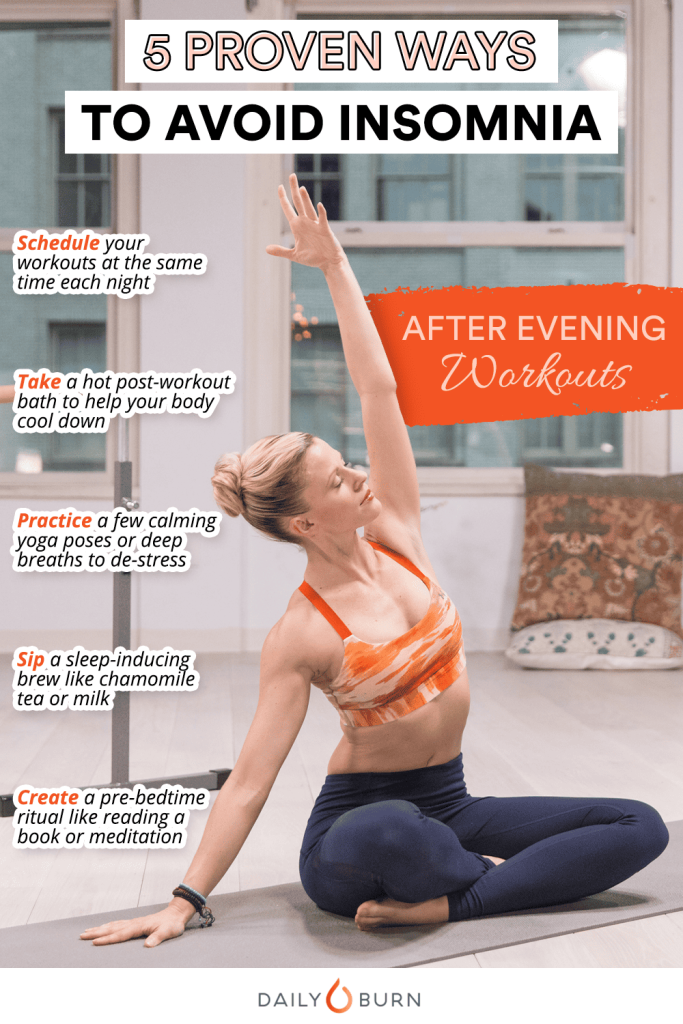You’ve heard that there are exercises for better sleep but you can’t seem to figure out exactly which exercises promote deeper sleep.
To make things worse, you’ve also read that lots of exercises can actually induce insomnia. So, which is which?
Don’t lose sleep trying to figure out which exercises will help you drift off more easily. There are plenty of great options to help you ward off poor sleep by moving your body in a gentle way.
Read on to learn about nine exercises for better sleep.

Is It Bad to Exercise at Night?
The list of the benefits of exercise goes on and on – add sleep to that list. Numerous studies confirm that the effects of exercise on sleep are positive.
The real question isn’t about whether regular exercise helps you sleep better. The real question is about when you should do that exercise and what types of exercise you should be doing.
According to Christina Spengler, head of the Exercise Physiology Lab at ETH Zurich,
“If doing sport in the evening has any effect on sleep quality at all, it’s rather a positive effect, albeit only a mild one.”
However, there’s an exception to the rule that exercise helps sleep. Research shows that to sleep better at night, vigorous workouts within one hour of bedtime should be avoided.
As Spengler continues,
“As a rule of thumb, vigorous training is defined as training in which a person is unable to talk. Moderate training is physical activity of an intensity high enough that a person would no longer be able to sing, but they could speak.”
A recent study showed that high-intensity workouts one hour before sleep do not allow the body sufficient time to recover and therefore your heart rate is too high to be able to fall asleep easily.
9 Exercises for Better Sleep to Add to Your Bedtime Routine
Chronic sleep deprivation can lead to a sleep disorder so it’s something worth avoiding.
The good news is that there are plenty of moderate to low-intensity exercises for sleep that you can do tonight.
Check out some of these sleep specialist favorites to ward off insomnia and help you get deeper sleep, avoid daytime sleepiness, and enjoy a better quality of life.
1. Figure-four stretch
The figure-four stretch is a great way to wind down your day and get ready for bed.
To do this stretch, lay on your back with your feet flat on the floor. Cross your right ankle over the top of your left knee. Keep your right foot flexed.
Next, use your arms to slowly bring your left knee toward your chest until you feel a gentle stretch in your right hip and glute. This position should look like the number four.
Hold there for 3-5 breaths and repeat on the other side.
Muscle tension before bedtime is something you want to avoid. The figure-four stretch has the double benefit of giving your glutes and hips a nice stretch and also doing some relaxing breathwork before bed.
2. Cat/cow
This is another great pre-bedtime stretch that is a staple in yoga classes.
It helps to stretch out your back muscles in combination with mindful, relaxing breathwork.
Begin on your hands and knees, known as tabletop position.
First is cow pose. From tabletop position, press your chest forward and let your stomach sink toward the floor. Lift your head and relax your shoulders away from your ears. You should be gazing forward.
Next is cat pose. Imagine a cat arching its back. Glide into this pose from cow pose. Exhale and gently round your spine, tuck your tailbone, and bring your pubic bone forward. Don’t force your chin to your chest, just relax.
Inhale and move back into cow pose.
Repeat this dynamic stretch for one minute, focusing on your breathwork, as you slowly flow between cat and cow for some relaxing yoga before bed.
3. Knee to chest twist
In keeping with the theme of stretches for better sleep, the knee to chest twist is an effective bedtime exercise for good sleep.
The technique for this low back/hip stretch is simple. Begin by laying on your back with your arms outstretched like a T, palms up.
Exhale, bend your right knee and bring it toward your chest while keeping your left leg extended on the floor, foot flexed.
Cross your right knee over the midline of your body toward the left. Your hips should be stacked on top of one another now.
To get a bit more stretch, and if it feels ok, you can rest your left hand on your right knee and apply gentle pressure. Turn your head to look toward the fingertip of your outstretched right arm to stretch neck muscles.
Continue to take slow breaths as you do this activity. Hold for several breaths and then repeat on the other side.
Twists are good exercises for better sleep because they also can help alleviate digestive issues that may be keeping you from comfortably falling asleep.
4. Walk around the block
A common leisure-time physical activity, a walk around the block in the evening can be a relaxing way to end your day while also doing some light, sleep-inducing exercise.
Assuming you aren’t experiencing cold weather or a heatwave, a walk around the block could be just the physical activity that your body needs to help drift off to sleep comfortably.
5. Reclining bound angle
This is a classic restorative yoga pose which means it can help with symptoms of insomnia and relieve stress. It gives a passive stretch for your inner hips and groin.
To begin, lay in a comfortable position on your back with your palms facing upward.
Bend your knees and bring the soles of your feet together. Let your legs fall open and allow gravity to slowly pull your knees toward the ground.
To deepen the stretch, you can bring your feet closer to your body. If you’re feeling particularly tight, you can move your feet away from your body to lessen the stretch.
Stay here and do some deep breathing to help relax your mind and body for sleep. 1-5 minutes is recommended.
6. Progressive muscle relaxation
Of all the relaxation techniques to sleep, progressive muscle relaxation (PMR) is one of the favorites.
As stress and anxiety build throughout your day, you experience increased muscle tension which is not conducive to quality sleep.
Progressive muscle relaxation is an activity where you practice intentionally tensing a specific group of muscles, breathing, and in a controlled, mindful way, releasing the tension from the muscles.
The theory is that by releasing physical tension, you can also release mental tension.
Studies show that PMR can reduce anxiety and improve sleep quality, making it one of the top exercises for better sleep.
7. Standing forward bend
This is about as simple as it gets when it comes to a sleep-inducing activity.
This pose is known to quiet the mind, stretch the backs of your legs, improve digestion and alleviate anxiety — all things that sound pretty good if you’re looking for a good night’s sleep.
Begin in a standing position with your feet together, hands at your sides. Inhale and raise your arms over your head. Exhale and hinge at your hips while drawing your belly in and reaching your hands toward your feet.
Place your hands or fingertips on the floor in front of or next to your feet. You can also hold the back of your ankles or calves. If your yoga practice is still new and you can’t touch your toes yet, use a yoga block at your feet to reach toward.
Make sure to let your head hang and relax your neck.
If you are really tight, remember to let your knees bend a little bit in to keep the length in your spine. You can also rotate your inner thighs inward to give you more room to fold.
Slowly come back to standing position. Be particularly careful about this because you may feel a bit dizzy.
Take that nice stretch and head into the bedroom for a relaxing night’s sleep.
8. Easy body weight exercises
A form of resistance training, bodyweight exercises use gravity as resistance, rather than using weights (like in heavy weightlifting). While these can be quite challenging, there are plenty of easy exercises you can do to promote sleep.
Push-ups, squats, and sit-ups are examples of simple bodyweight exercises that you can do to get a little extra calorie burn but also get the sleep benefit of light exercise before bed.
9. 4-7-8 breathing exercises
The 4-7-8 breathing technique was developed by Dr. Andrew Weil, founder and director of the University of Arizona Center for Integrative Medicine.
This relaxation technique arises from pranayama yoga which emphasizes control over your breathing.
Controlled breathing helps you take in more oxygen which promotes relaxation.
To do the 4-7-8 breathing technique, inhale through your nose for 4 seconds, hold your breath for 7 seconds, exhale for 8 seconds.
There isn’t a significant body of research on the effectiveness of this yet, but there are plenty of people who say that it helps them fall asleep quickly.
Give it a try to help relax your mind and body to prepare for sleep.
To conclude…
In addition to optimizing your sleep hygiene and aiming for 7-9 hours of sleep per night, adding some of these activities to your bedtime routine can result in improved sleep quality.
The relationship between sleep and exercise is clear. But make sure to keep your workout light to moderate (avoid vigorous exercise an hour before bed) to give your body enough time to recover so that you can get a restful sleep.
Join our closed Facebook group, Sleep Tips, to get some more ideas and share your own workout experiences.

Welcome to Snoozerville! I’m Dr. Alex Hartley, your guide to the world of restful sleep. With a Ph.D. in Sleep Science and years of experience as a sleep therapist, I’ve dedicated my life to understanding and improving sleep quality. My passion lies in uncovering the mysteries of sleep and sharing practical, science-backed advice to help you achieve the best rest possible. Beyond my academic pursuits, I’m an advocate for mindfulness and relaxation techniques, which I incorporate into my daily routine. At Snoozerville, I aim to transform your nights, combining the latest research with easy-to-implement tips. Whether you’re a chronic insomniac or just looking to improve your sleep hygiene, join me on this journey towards peaceful, rejuvenating sleep.
